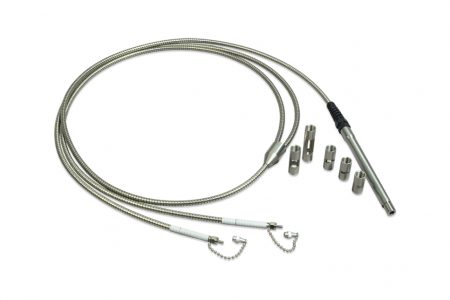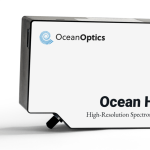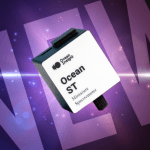Fiber Probes for Challenging Environments
One of the greatest strengths of a compact, modular spectrometer is its ability to be deployed in environments outside the traditional lab. When combined with fiber optic probes that extend the spectrometer’s reach, the possibilities expand further. The flexibility of optical fiber cables permits probes to be routed into tight places, and allows centralization of the spectrometer and analysis at a distance from the actual measurement. The wide variety of probe sizes and configurations available allows light to be delivered to diverse environments, from conditions of high heat and pressure to deep within delicate samples. Let’s look at some probes designed for difficult applications and measurement conditions, from flames to brains.
High Temperature Probes for Flames and Plasmas
High heat has the potential to melt or otherwise damage fiber optic probes, but our FL-400 flame resistant fiber probe uses a gold-buffered 400 µm fiber in narrow stainless steel tubing to withstand temperatures up to 750 °C. At 20 cm in length, it can be positioned to measure high temperature flames, furnaces or plasmas at close range while protecting the routing fiber from heat. It also comes with a removable nickel wire loop at the probe tip for observing flame emission spectra from solutions such as sodium, potassium, calcium and copper in the teaching lab.
High Pressure Transmission Probes for Process
Industrial processes often work at high temperature and pressure, and require robust probes that can withstand rough handling and use of fittings for insertion into process streams, pipes and reactors. Most industrial-grade transmission probes work on the same principle: light is directed via one fiber through the open path, then is reflected by a mirror and redirected back to a receive fiber that returns the light to the spectrometer. The sample is free to flow through the tip, providing ongoing measurements of transmission in the liquid. Applications of these probes include agricultural measurements and monitoring, water quality analysis, biofuels production, biotechnology applications, and food and beverage quality control.
Our TI300-Series industrial transmission process probes can be used in environments with pressure limits of up to 250 psi and at temperatures up to 300 °C. The robust stainless steel 1/2″ probe tip is ideal for integration into process lines, and mates easily to our spectrometers and light sources for measurement of absorbance and transmission in solutions. The pathlength of the tip can be varied for solutions of different concentration (2 mm to 50 mm tips available). Our customers have used this probe for agricultural measurements and monitoring, water quality analysis and biotechnology applications.
We also offer probes for use at even higher pressures. These Single and Double Pass Transmission Probes are rated up to 7000 psi, making them ideal for online measurement of sample streams in demanding environments. Available in pathlengths from 1 mm to 20 mm, they can be sourced in a variety of materials to best suit your process (316 stainless steel, Hastelloy C, titanium and Monel body materials; quartz and sapphire windows; and Viton, Chemraz and Kalrez seals). These robust probes possess linearity superior to that of our standard transmission dip probes, and can be used as part of a process system or combined with our spectrometers and accessories to create real-time monitoring systems for a variety of transmission applications.
High Pressure Fluorescence Probes for Process
Fluorescence is often used as a sensitive method of process monitoring for highly scattering mixtures, particularly for gauging the effectiveness of mixing or to assess concentrations of an added ingredient. For these applications, we offer a Front-Surface Fluorescence Probe, ideal for measuring fluorescence at the surface of a liquid, solid, paste or slurry. It can be used as part of a process system or combined with our spectrometers and accessories to create a real-time monitoring system. Specially designed to have a very sharp focus at the wetted end of the sapphire window, this 30 cm long probe need not penetrate deeply into the sample to obtain a reading, and can be inserted into a standard benchtop fermenter via a PG-13.5 fitting for operation at pressures up to 7000 psi and temperatures up to 300 °C. Other applications of these probes include biofuels production, biotechnology applications, food and beverage quality control and polymer analysis.
ATR Probes for Optically Dense Media
Some processes involve highly absorbing samples that are not well suited to either transmission or fluorescence monitoring. Attenuated total reflection (ATR) uses total internal reflection within the probe tip to generate an evanescent wave that penetrates 0.5-2 µm deep into a liquid sample, effectively creating an ultrashort pathlength absorbance measurement. By mating an Attenuated Total Reflection Probe with an Ocean Optics spectrometer system, highly absorbent samples up to the 4000-5000 AU/cm range can be measured via direct insertion of the probe into the sample without sample dilution. ATR is an excellent tool for the analysis of pure inks, dyes and crude oil samples. This probe can also be used as a general deposition probe if the refractive index of the material that is depositing on the probe tip is greater than that of the probe’s sapphire crystal (i.e., greater than 1.7).
Oxygen Sensing Probes for Tissue and Industrial Samples
Optical oxygen sensing using phase detection of fluorescence in our proprietary sensor materials enables dissolved and gaseous oxygen pressure to be measured in a range of environments that would be challenging for a traditional oxygen electrode. NeoFox oxygen sensing systems consume no oxygen, can maintain continuous contact with viscous samples, and move easily between gas and liquid upon recalibration. Our oxygen probe offerings range from ruggedized probes for process to narrow, flexible probes for use in delicate tissue.


Other working environments are hostile to metallic probes, in which case a polyimide-coated PI600 Oxygen Sensor Probe is a good solution. Polyimide offers good resistance to harsh chemicals, while the silicone jacket offers protection for the probe in routing. Narrow in diameter, it is also good for applications requiring fine spatial resolution. A silicone jacket covers the majority of the probe’s 18 cm length, with a 710 µm diameter polyimide-coated fiber tip exposed at the end. This probe has been used in measurement of tissue oxygenation in studies of stem cell therapies to treat peripheral artery disease (see our application note, “Bringing New Life to Old Arteries with Oxygen”).
One of the most extreme oxygen sensing applications we see regularly involves measurement of the oxygenation of brain tissue in animal studies. These experiments often use our AL300-TM Oxygen Sensor Probe, composed of aluminum-buffered fiber that is merely 420 µm in diameter, supported by a 1/16” stainless steel sleeve for all but the 1” of exposed tip. The slender fiber provides fine spatial resolution for probing into tissue, while the sleeve adds positioning stability for applications involving soft tissue.
Other applications require no probe at all, a need that is easily accommodated by our RedEye Oxygen Sensing Patches. Designed for non-invasive oxygen monitoring, these easy to use, peel-and-stick indicator patches can be placed on the interior of sample packaging, containers or a chamber for measurement by an external probe. This probe-patch setup can be used to measure oxygen safely and non-invasively in sealed packaging and containers used in medical, pharmaceutical and food applications, as well as in process lines and reactor vessels for research.
RedEye Oxygen Sensing Patches have been used to monitor oxygen during E. coli Fermentation. Read the application note here.
Summary
Whether working in delicate tissue or a high pressure, high temperature process line, Ocean Optics probes offer a wide variety of solutions to provide reliable answers in even the most extreme environments. As part of our line of flexible, configurable spectroscopy solutions, fiber optic probes allow spectroscopic analysis to be taken from the lab to the process line, through packages, and even inside the brain.











